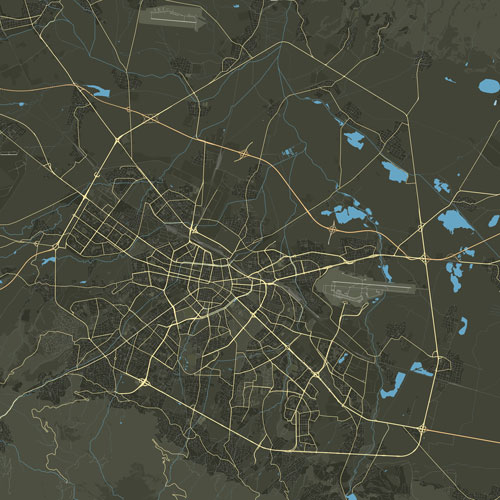In 1921, the Romanian Queen Maria decided to visit Balchik, intrigued by the stories of her friends Prince Satmare and his wife Ortanza, who called the city a “green oasis”. Captivated by the natural charm of the place, from the white cliffs and the calm sea, she decided to build her summer residence here and in 1937 the palace was ready. She called it “The Quiet Nest.” Fortunately, she had a strict requirement: the creation by human hands should not disturb the natural beauty and magnificence of the area.
What immediately catches the eye are the various religious plots, the architectural composition, the mythological characters.
Specially invited to create the beautiful parks was the Swiss Jules Jeanny, who until the revolution in Russia was the chief gardener of Emperor Nicholas II. After his death in 1937, his work was completed by Gutmann, another Swiss of Jewish origin. Much of the charm of the park today is due to their skills and efforts. The individual parts of the park and the palace bear different names: the Gethsemane and the Weeping Gardens, the Gardens of Allah, the Cruciform Water Mirror, the English Court, the Bridge of Sighs, the Alleys of Wine and the Ages, the Hanging Gardens, the springs “White Well” and “Chatal Fountain” , the Nymphaeum/Roman bath/, beautiful waterfalls, water channels, labyrinths of mysterious and beautiful places.
There are no imposing pompous buildings here, no aspiration to inspire grandeur or power. On the contrary – everything created by man is written into the landscape as if it had always been here – the small stone villas with roofs of Turkish tiles that once housed the queen, her family and entourage are scattered throughout the magnificent park. The huge sedges that grew along the river were deliberately bypassed when laying the lanes, even the three mills are still here.
Villa “Tihoto gezdo” – the villa of the queen. It was built in 1925 based on initial sketches by the Romanian artist Alexandru Satmari, which were reworked into architectural drawings by the military architect Emil Gunes (1890–1945). Soldiers under the leadership of General Zion, under the supervision of Queen Mary’s personal secretary, Gaetan Denis, participated in the construction.
Roman Loggia (Nymphaeum) – The original name of this stone pergola is Suliman Leïc – Waters of Peace. Today it is better known as Nymphaeum, as nymphaeums are temples of the ancient Greek goddesses of water. The three-jet fountain on the north side of the Nymphaeum has existed here for centuries.
Noteworthy are the chapel “Stella Maris” (built in 1929 – 1930) and the tomb of Queen Mary.
The chapel “Stella Maris” is a copy of a church from the 15th century, which still exists today in the northern part of the island of Cyprus. called St. James and is located in the village of Trikomo or Yeni Iskele (the Greek and Turkish name of the village), 20 km from the city of Famagusta. The Queen visits Trikomo and likes the church very much. She sends a special stonemason to take the dimensions and build such a temple in her residence in Balchik.
The palace in Balchik is a kind of architectural interpretation of its creator Maria’s desire for beauty and harmony. A romantic escape from reality to the magic of nature.
On the evening of July 18, 1938, after a serious illness, Queen Mary died. Her last wish – that her heart be kept in the palace – was fulfilled. Later, when Southern Dobrudja was returned to Bulgaria under the Treaty of Krai, on September 8, 1940, the casket with the heart of Queen Mary was taken out of the Assumption Chapel ” and returned to Romania.
Work time:
The “Palace” architectural and park complex is open for visits all year round, including weekends and holidays. Architectural and park complex “Dvoretsa” is accessible from 3 entrance points – from its northern side /official entrance/, from the seaside road “Balchik – Albena”, as well as from the sea.
Box Office and Museum Hours:
Winter Hours: 9:00 a.m. to 5:00 p.m. Summer Hours: 8:00 a.m. to 8:00 p.m.; Working hours of the Reception of the villa village “Dvoretsa”: Winter working hours: from Monday to Friday – 8:30 – 17:00, Saturday and Sunday – 24/7. Summer working hours: Around the clock, without a day off. Working hours of the Cultural Administration “Palace” center: From Monday to Friday – 9:00 a.m. to 5:30 p.m.
Entrance fees:
Adults – 15 BGN
Children /from 7 to 18 years old / – 3 BGN
Children up to 7 years old – free entrance
Package price for a family visit (parents with children) – 22 BGN
Expedients – 3 BGN
Pensioners, students and learners (up to 25 years old) – 3 BGN
People with special needs – free entry and mobile equipment
Photo with the Queen – BGN 2 Group visits / upon presentation of a list /:
For a group of adults – the guide / tour guide / enters for free;
For a group of children/students – one leader per 10 children enters for free.
Contacts:
Architectural and park complex “Palace”
Tel: +359 579 76854 and +359 579 725 66
Website

